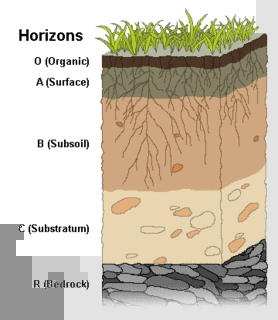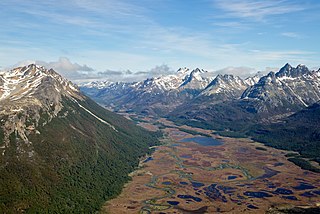
In soil science, humus denominates the fraction of soil organic matter that is amorphous and without the "cellular cake structure characteristic of plants, micro-organisms or animals." Humus significantly affects the bulk density of soil and contributes to its retention of moisture and nutrients.

Trinitrotoluene (; TNT), or more specifically 2-methyl-1,3,5-trinitrobenzene, is a chemical compound with the formula C6H2(NO2)3CH3. This yellow solid is sometimes used as a reagent in chemical synthesis, but it is best known as an explosive material with convenient handling properties. The explosive yield of TNT is considered to be the standard measure of bombs and the power of explosives. In chemistry, TNT is used to generate charge transfer salts.

Mycelium is the vegetative part of a fungus or fungus-like bacterial colony, consisting of a mass of branching, thread-like hyphae. The mass of hyphae is sometimes called shiro, especially within the fairy ring fungi. Fungal colonies composed of mycelium are found in and on soil and many other substrates. A typical single spore germinates into a homokaryotic mycelium, which cannot reproduce sexually; when two compatible homokaryotic mycelia join and form a dikaryotic mycelium, that mycelium may form fruiting bodies such as mushrooms. A mycelium may be minute, forming a colony that is too small to see, or it may be extensive, as in Armillaria ostoyae:
Is this the largest organism in the world? This 2,400-acre [970-hectare] site in eastern Oregon had a contiguous growth of mycelium before logging roads cut through it. ... Mushroom-forming forest fungi are unique in that their mycelial mats can achieve such massive proportions.
The Food and Agriculture Organization of the United Nations (FAO) developed a supra-national classification, also called World Soil Classification, which offers useful generalizations about pedogenesis in relation to the interactions between the main soil-forming factors. It was first published in form of the UNESCO Soil Map of the World (1974). Many of the names offered in that classification are known in many countries and do have similar meanings.

Topsoil is the upper, outermost layer of soil, usually the top 5 inches (13 cm) to 10 inches (25 cm). It has the highest concentration of organic matter and microorganisms and is where most of the Earth's biological soil activity occurs. Topsoil is composed of mineral particles, organic matter, water, and air. Organic matter varies in quantity on different soils. The strength of soil structure decreases with the presence of organic matter, creating weak bearing capacities. Organic matter condenses and settles in different ways under certain conditions, such as roadbeds and foundations. The structure becomes affected once the soil is dewatered. The soil's volume substantially decreases. It decomposes and suffers wind erosion.
USDA soil taxonomy (ST) developed by United States Department of Agriculture and the National Cooperative Soil Survey provides an elaborate classification of soil types according to several parameters and in several levels: Order, Suborder, Great Group, Subgroup, Family, and Series. The classification was originally developed by Guy Donald Smith, former director of the U.S. Department of Agriculture's soil survey investigations.
Humic substances are organic compounds that are important components of humus, the major organic fraction of soil, peat, and coal. For a long era in the 19th and 20th centuries, humic substances were often viewed through a lens of acid–base theory that described humic acids, as organic acids, and their conjugate bases, humates, as important components of organic matter. Through this viewpoint humic acids were defined as organic substances extracted from soil that coagulate when a strong-base extract is acidified, whereas fulvic acids are organic acids that remain soluble when a strong-base extract is acidified.

Alfisols are a soil order in USDA soil taxonomy. Alfisols form in semiarid to humid areas, typically under a hardwood forest cover. They have a clay-enriched subsoil and relatively high native fertility. "Alf" refers to aluminium (Al) and iron (Fe). Because of their productivity and abundance, the Alfisols represent one of the more important soil orders for food and fiber production. They are widely used both in agriculture and forestry, and are generally easier to keep fertile than other humid-climate soils, though those in Australia and Africa are still very deficient in nitrogen and available phosphorus. Those in monsoonal tropical regions, however, have a tendency to acidify when heavily cultivated, especially when nitrogenous fertilizers are used.

Soil conservation is the preventing of soil loss from erosion or reduced fertility caused by over usage, acidification, salinization or other chemical soil contamination.
The World Reference Base for Soil Resources (WRB) is an international soil classification system for naming soils and creating legends for soil maps. The currently valid version is the Update 2015 of the third edition 2014. It is edited by a working group of the International Union of Soil Sciences (IUSS).

The Semien Mountains, in northern Ethiopia, north east of Gondar in Amhara region, are part of the Ethiopian Highlands. They are a World Heritage Site and include the Simien Mountains National Park. The mountains consist of plateaus separated by valleys and rising to pinnacles. The tallest peak is Ras Dejen ; other notable heights include Mounts Biuat and Kidis Yared.
This is an index of articles relating to soil.

A Gley is a wetland soil that, unless drained, is saturated with groundwater for long enough periods to develop a characteristic gleyic colour pattern. This pattern is essentially made up of reddish, brownish or yellowish colours at surfaces of soil particles (peds) and/or in the upper soil horizons mixed with greyish/blueish colours inside the peds and/or deeper in the soil. Gleysols are also known as Gleyzems and meadow soils (Russia), Aqu-suborders of Entisols, Inceptisols and Mollisols, or as groundwater soils and hydro-morphic soils.

Clomazone is an agricultural herbicide, and has been the active ingredient of products named "Command" and "Commence". The molecule consists of a 2-chlorobenzyl group bound to a N-O heterocycle called isoxazolidinone. It is a white solid.
The Canadian System of Soil Classification is more closely related to the American system than any other, but they differ in several ways. The Canadian system is designed to cover only Canadian soils. The Canadian system dispenses with the sub-order hierarchical level. Solonetzic and Gleysolic soils are differentiated at the order level.
The town of San Jose de Gracia is located in the
Township Tepatitlán, Jalisco in the Sur region Altos
(State of Jalisco) at 95 km from the city of
Guadalajara toward the northeast. Founded in the
1793.
It has 8765 inhabitants, situated at an altitude in XXX
1980 m, with a pleasant temperate climate and gentle
prevailing winds from the east. Its population
neighboring: Capilla de Guadalupe, San Ignacio Cerro Gordo,
Arandas, St. Francis of Assisi, and Tototlán Atotonilco.
Calcids are a soil suborder in the USDA soil taxonomy. They are aridisols that have accumulated high levels of residual or dryfall calcium carbonate.

A mire is a wetland type, dominated by living, peat-forming plants. Mires arise because of incomplete decomposition of organic matter, due to waterlogging and subsequent anoxia. Like coral reefs, mires are unusual landforms in that they derive mostly from biological rather than physical processes, and can take on characteristic shapes and surface patterning.

Zinc deficiency occurs when plant growth is limited because the plant cannot take up sufficient quantities of this essential micronutrient from its growing medium. It is one of the most widespread micronutrient deficiencies in crops and pastures worldwide and causes large losses in crop production and crop quality.
The Polish Soil Classification is a soil classification system used to describe, classify and organize the knowledge about soils in Poland.













